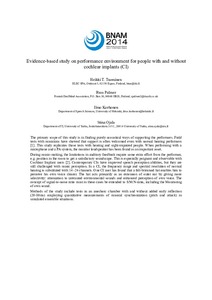Evidence-based study on performance environment for people with and without cochlear implants (CI)
Heikki T Tuominen; Russ Palmer; Ilmo Korhonen; Stina Ojala
https://urn.fi/URN:NBN:fi-fe2021042714410
Tiivistelmä
The primary scope of this study is in finding purely acoustical ways of supporting the performers. Field
tests with musicians have showed that support is often welcomed even with normal hearing performers
[1]. This study replicates those tests with hearing and sight-impaired people. When performing with a
microphone and a PA system, the monitor loudspeaker has been found as an important asset.
During music-making, the limitations in auditory feedback require some extra effort from the performer,
e.g. position in the room to get a satisfactory soundscape. This is especially poignant and observable with
Cochlear Implant users [2]. Contemporary CIs have improved speech perception abilities, but they are
still challenged with music perception. In a CI, the frequency range and spectral resolution of normal
hearing is substituted with 14 -24 channels. One CI user has found that a felt-brimmed hat enables him to
perceive his own voice clearer. The hat acts primarily as an extension of outer ear by giving more
selectivity: attenuation to unwanted environmental sounds and enhanced perception of own voice. The
concept of signal-to-noise ratio must in these cases be extended to S/M/N-ratio, including the Monitoring
of own sound.
Methods of the study include tests in an anechoic chamber with and without added early reflection
(20-80ms) employing quantitative measurements of musical synchronization (pitch and attack) in
simulated ensemble situations.
Kokoelmat
- Rinnakkaistallenteet [27094]
